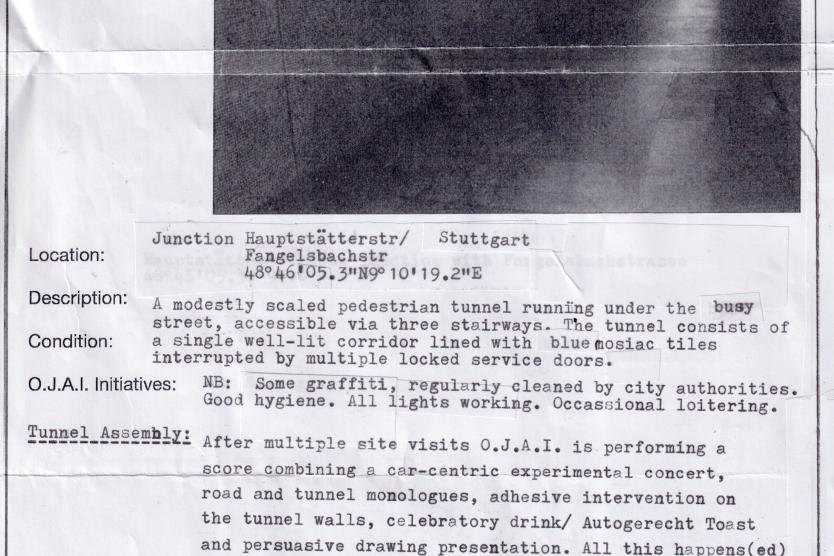
In Tunnel Assembly, Office for Joint Administrative Intelligence (O.J.A.I.) explore a pedestrian underpass beneath Stuttgart’s Hauptstätter Straße through sound, ritual, and speculative infrastructure studies. The performance continues their ongoing investigation into motorway architectures and the overlooked spaces they produce. CURRENT asked the artist duo—Chris Dreier and Gary Farrelly—three questions about tunnels, walking, and the art of bureaucratic imagination.
CURRENT: Office for Administrative Joint Intelligence (O.J.A.I.) operates as a bureaucratic para-intelligence agency. How does adopting this institutional persona shape your artistic approach, and what role does administrative language or structure play in your critical engagement with systems of power?
O.J.A.I: At O.J.A.I., the institution is not a fixed building or bureaucratic body, but a constructed entity—assembled from our improvised tools, procedures, and rituals of officialdom. We perform our own version of authority, conjuring continuity and control through naming, protocol, and performative compliance. Institutionality, for us, is a way of making things appear. It lets us render visible—and self-validate—the legitimacy of our research concerns: tunnels, peripheries, defamed structures, infrastructural memory, and sonic archaeology. These obsessions are activated and made operational within an artistic logic. One might call this a critical manoeuvre, as a means of appropriating power toward shared obsession and speculative legitimacy.
CURRENT: Tunnels, underpasses, and overlooked infrastructures appear frequently in your work—including the underpass beneath Stuttgart’s Hauptstätter Straße in your recent performance Tunnel Assembly. What draws you to these spaces, and how do they figure into your broader exploration of infrastructural memory and excess architecture?
O.J.A.I: We gravitate toward overlooked infrastructures—tunnels, stairwells, lobbies, administrative buildings, and dried-up fountains—because they are evidential remains of defunct, defamed, or failed urban management. It’s a kind of archaeology that tells us things about the recent past. These spaces—particularly pedestrian tunnels, which are completely out of fashion—often unloved and neglected, call out for human attention and ritual. We read them as scenographies: latent design propositions that can be reactivated through our work.
CURRENT: Much of your practice unfolds on foot—through guided walks, site visits, and ritualized movement. How does walking function as a mode of research, especially within urban environments designed more for cars than for pedestrians?
O.J.A.I: We were walking together long before we named it methodology—visiting office blocks, fountains, tunnels, airport terminals, and public plazas as a way of tuning ourselves to the built world. Walking became essential because we recognise that the fossilised layers of design, politics, and speculation embedded in the landscape far exceed anything we could fabricate in a studio. It’s a scouting practice, a research protocol, a ritual. We walk together, and we curate walks as invitations into our speculative reading of the built environment. Even under tightly prescribed O.J.A.I. walking conditions, participants bring their own urgencies, associations, and subjectivities—and they find what we would never think to look for. As for roads: we walk them because they resist us. That resistance suits us. We aren’t easy-going people.
Photo Credits
1. Standard tunnel file by O.J.A.I. featuring official letterhead, typewritten annotations, validation stamps, and signatures.
2. Labeled diagram of the performance setup including toy car sounds, modular instruments, output devices, and typewritten instructions.
3. Photograph of Chris Dreier and Gary Farrelly traversing a section of a pedestrian tunnel on the outskirts of Charleroi, Belgium.